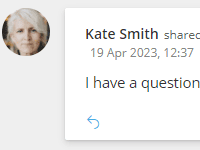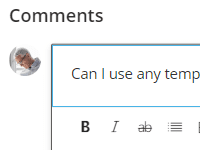
GLUU GUIDES
Selecting the best business process management (BPM) software in the age of Gen AI
Finding the best business process management software is hard. Most classic tools are too complex for normal companies. Others merely manage tasks. This guide covers eight key areas with 27 requirements for the right tool to help Process Excellence teams succed with user adoption. We’ve just update the guide with ‘suitability for generative AI’ as an eight key area to look for.
Table of contents
- Selecting the best business process management (BPM) software in the age of Gen AI
- How business process management software can help
- 8 key areas to look for when selecting BPM software
- #1 Easy to implement and use
- #2 Makes your standard way of working easy to understand
- #3 Enables ongoing communications and feedback
- #4 Makes processes easier to execute the right way
- #5 Collects input and data to improve business processes
- #6 Integrates with other systems to automate tasks
- #7 Ensures solid governance around processes
- #8 Can work directly with AI agents
- Next step: The vendor evaluation
- Conclusion
- Frequently Asked Questions
Looking for something else? Explore these related articles:
In this guide you will get eight key areas to look at when picking BPM software. Each area is divided into sub-requirements that you can use for finding just the right tool for your needs.
8 key selection criteria for BPM software
- Make it easier to get business users involved
User adoption among real business users is everything. Period.
- Make your ‘standard way of working’ easy to access and understand
Processes are all about communicating your standard work. This means both flows and work instructions.
- Enable ongoing communications and feedback
Business processes must be easy to change to reflect ongoing learning. Otherwhise they quickly become irrelevant. For this you need a closed loop of feedback, changes and communications with business users.
- Make processes easier to execute the right way
Standardized and accessible processes is one thing, actually ensuring their execution is another. Make sure that you can take the process all the way to execution in the BPM software.
- Collect input and data to improve business processes
Continuous process improvement is critical. This is why you need data from running process – and qualitative feedback from users.
- Integrate with other systems to automate tasks
A BPM platform cannot be in island. Over time, you will need to connect it with other business systems through RPA, integrations and bots.
- Ensure solid governance around processes
Managing hundreds of processes require structure and organization. This means clear roles, process ownerships and delegated rights to manage processes.
- Can work directly with AI agents
Soon you’ll see more an more AI agents completing process tasks and activities. They need to understand what to do just as well as other business users. Your new BPM software must facilitiate this.
Before we dive into each of the eight criteria in more detail, then let’s first take a look at…
How business process management software can help
‘Business process management‘ is a big effort to visualise, execute, improve and manage a company’s recurring work across roles, on an ongoing basis and on one single platform.
Organisations buy and deploy process management software to get the tooling they need to succeed with business processes. So what does success look like? It can be to…
- Standardise an organization’s ways of working
- Ensure faster employee onboarding (interested in how? read our guide to employee onboarding)
- Retain knowledge in a system (and not in the minds of individuals)
- Allow your company to grow and scale faster
- Improve business processes to reduce waste and errors
- Digitalize paperwork and automate manual processes to save time
- Safeguard and document regulatory compliance with external standards such as ISO or GDPR
There are hundreds of tools out there. Depending on your own success definition and your current systems the best choice for one company may not be the best for another. This guide will help you to connect what matters to your company with the right tools.

8 key areas to look for when selecting BPM software
The best business process management software solution will allow you to say a clear “yes!” to the criteria that matter to you:
- It is easy to implement and use for both process excellence team, process owners and business users.
- It makes our standard way of working easy to understand
- It enables ongoing communications and feedback so that business users get involved
- It makes processes easier to execute the right way
- It collects input and data to improve business processes
- It integrates with other systems to automate tasks
- It ensures solid governance around processes.
- It can work directly with AI agents.
Now, let’s look at each area and its requirements.
#1 Easy to implement and use

As a start it is important to remember that the tool isn’t the goal. The goal is that business users – your own colleagues – will be able to manage and work with their processes on a daily basis. To succeed with process management your main objective is therefore to select BPM software that will help business process understanding, use, execution and improvement. This means you should add requirements like these:
- The BPM tool must require maksimum 3 hours training for advanced users, and 1 hour for business users. This makes it realistic to involve your colleagues effectively without requiring full time process experts.
- Must combine effective search, process maps, work instructions and communications in a seamless flow that regular uses can use for guiding work. Why? These elements are all important when trying to establish standard work in practice. Having them disconnected introduces a lot of friction that will slow down daily usage among business users.
For this reason, we’re not including a number of highly complex development and automation platforms from this analysis. However, this doesn’t mean that they may not be very valuable for other use cases. We list such platforms at the bottom of our article Top 5 BPM software reviewed.
#2 Makes your standard way of working easy to understand
It’s only if your shared, standard way of working is easier to follow and use than your colleague’s individual habits that it will actually become reality. For instance, if a business user needs to procure a new service and he can choose between a complex, error-prone flow in an ERP system, or just sending a mail to a secretary, he will always use the second option. So while avoiding the secretary is efficient for the company as a whole, it is not so for the specific user. In practice, this means that you should look for the following features:
- Ability manage, view and filter a full inter-connected process repository with different owners, editors.
- Visual process mapping – a simple, visual flow makes it easier to understand responsibilities.
- Organisational roles, job descriptions and processes assigned to business users.
- Reusing processes and activities across the account to avoid content duplication.
- Work instructions (with video, files, links and images) that connect with activities in processes.

#3 Enables ongoing communications and feedback
This requirement is closely related to the one before. Chances are that the first time a new colleague sees a process or a work instruction a few questions will come to mind. Questions must be captured and directed to the process owner so they can be answered immediately. Otherwise business users will quickly loose patience and conclude that the common way of working doesn’t make sense. Ideally, this conversation between user and editor should be transparent to everyone, so questions only need to be asked and answered once. So, this is why you should look for these features:
Ability to discuss processes and activities inside the tool.
- Common tags or labels to flag comments for follow up.
- Ability to raise issues and change requests and complete a formalized approval flow.
- Filter comments and change requests.
Examples of features for effective communication:

Process-specific activity feed
Track comments and replies within processes to preserve feedback context and avoid lost emails.

Integrated work-specific Q&A
Let users ask clarifying questions about activities to improve understanding and quality of work.
#4 Makes processes easier to execute the right way
Actually running and executing your processes will ensure that they happen every time. As a result, you need ways to manage recurring tasks and cases. The correct staff need to know when to execute tasks and to log their work. These are the features that will get you there:
- Run recurring tasks
- Run workflows “on demand” across the roles in a process
- Record the person and time when a task is done
- Proof that a task is done (e.g. with location and photo)
- Monitor if tasks are not done in time
- Report on tasks by time, process and case.
This may not be relevant for larger organizations where process understanding and execution happen at different organizational levels. However features to orchestrate process execution can help you to test processes, prepare for systems implementation and conduct e.g. Value Added Time Analysis when doing process improvement. Merely having processes as documentation will not enable you to do this.
#5 Collects input and data to improve business processes
Once your processes are mapped and have been revised so many times that they are stable, then the time will come to improve them. In order to gather sufficient data to underpin your decisions, you need to collect organised feedback from colleagues (if processes are executed manually) and system data if processes are automated. These are important features for business process management software:
- See the volume of coworkers that have a problem, or request a certain change.
- Identify tasks which are not meeting process standards in either time spent or quality.
- Get an overview of your worst performing processes.
- Perform ‘Value Added Time Analysis’ to identify bottlenecks and find improvement opportunities.
”If you do not know how to ask the right question, you discover nothing.”
W. Edwards Deming

#6 Integrates with other systems to automate tasks
Once processes are stable, it’s time to automate your processes fully. To achieve this your process management software either needs to complete the full flow inside the platform, or it must be able to integrate with other systems such as ERP or CRM. To do this you need the following features in the process management software solution that you select:
- An open, RESTful API that is accessible via a token.
- Comprehensive API documentation to allow developers to get to work.
- Ready-made connectors to your preferred systems.
#7 Ensures solid governance around processes
You must be able to manage your process collection, or process hierarchy, from a central place while still being able to delegate the management of specific processes to the people that know. At the same time, each process owner must have access to all the tools and information that he – and his editor team – need to manage the process effectively. This requires granular rights management:
- Firstly, Automatic change tracking: Changes in processes, work instructions and editors.
- Manage Rights by Process: Assign separate owners and editors to each process.
- Lastly, Manage Rights by Feature: Allow separate users to manage hierarchy, roles and users.
Interested in what this could look like in practice? Take a look at how it can be done:
#8 Can work directly with AI agents
A comprehensive and updated process repository that can answer What, Why, How and by Who standard work is done is fantastic foundation and enabler for deploying AI agents. With this the right people have defined the correct ways of working and with process owners you have governance in place. Now what remains is a powerful API that allows AI agents to query this. Specifically, you should add these requirements:
- Ability to blend AI agent tasks and human tasks in the process context so business users clearly understand the scope of their work.
- Ability to let AI agents query all data through the tool’s API.
- Ensuring that process owners can control and monitor how AI agents execute tasks.
Next step: The vendor evaluation
These were the 27 requirements that we have identified as being important for many business process management software buyers. However, we suggest you also add your own requirements to the list.
Next, it’s time to start evaluating business process management software. We’ve started with our own evaluation: Top 5 business process management software for medium-sized businesses.
Conclusion
Finding the right Business Process Management (BPM) software can be challenging. In this concise guide, we’ve outlined 27 crucial requirements for medium-sized organizations. Emphasizing ease of use, process understanding, ongoing communication, and solid governance, each criterion will contribute to successful BPM adoption by business users.
The overarching goal is to empower companies to standardize operations, streamline processes, and achieve sustainable growth. As you embark on the vendor evaluation journey, ensure seamless alignment between these requirements and your specific needs for an informed BPM software selection process.
Frequently Asked Questions
BPM software provides substantial benefits to medium-sized organizations. Firstly, it streamlines processes, ensuring a more efficient workflow. Secondly, it standardizes ways of working, promoting consistency across the organization. Lastly, it fosters sustainable growth by facilitating ease of implementation, employing user-friendly interfaces, and encouraging ongoing communication. This comprehensive approach ensures not only efficient execution but also a continuous improvement cycle within the organization.
The vitality of ease of implementation lies in ensuring that BPM software seamlessly becomes a practical tool for daily use among colleagues. By prioritizing user-friendly platforms, organizations empower their teams to effectively manage processes. Consequently, this approach leads to the successful adoption and implementation of BPM, fostering a streamlined and efficient workflow.
Integration with other systems is paramount for task automation within BPM software. This integration enables BPM software to seamlessly complete the full workflow or connect with existing platforms such as ERP or CRM. Consequently, this cohesive integration enhances efficiency and ensures a streamlined automation process.
Moreover, BPM software plays a significant role in continuous process improvement by collecting organized feedback from colleagues and system data. This enables users to not only identify and address problems but also analyze task performance. Additionally, it provides an overview of the organization’s worst-performing processes, fostering data-driven decision-making for enhanced efficiency and optimization.
